
Demand generation is the best marketing strategy for your B2B business to create and cultivate customer interest in your product or service offerings.
This generates sufficient demand for your product/service that further helps in driving sales and revenue growth for your business.
In this blog post, we are going to explore:
- What exactly is demand generation?
- Difference between demand generation and lead generation.
- Why it is the best marketing approach for a B2B business?
- 6 stages of demand generation you need to be aware of.
- 11 demand generation best practices you need to consider.
- How to measure the performance of demand generation campaigns?
- 4 B2B demand generation use cases you need to know.
Let’s dive in.
What Exactly is Demand Generation?
Demand generation is a marketing strategy focussed on building awareness and interest for your product or service with the intention of generating demand.
In other words, it’s a data-driven marketing strategy that leverages digital marketing channels to build brand awareness and to generate demand.
The ultimate goal of demand generation is to create a steady and predictable flow of qualified leads (for your sales team) that can be converted into customers.
To make your demand generation campaign a great success, you need to build a strong collaboration between your marketing and sales teams.
Now you may be thinking whether demand generation is same as lead generation.
Apparently, they are not.
Difference Between Demand Generation and Lead Generation
Often times, I’ve seen marketers using demand generation and lead generation interchangeably.
They don’t realize the fact that both the marketing strategies are different, and lead generation is a part of demand generation.
With lead generation, your target audience is actively seeking for a solution as they are already aware of their pain point.
The main objective of lead generation is to capture a prospect’s information and continue nurturing the relationship with that B2B customer.
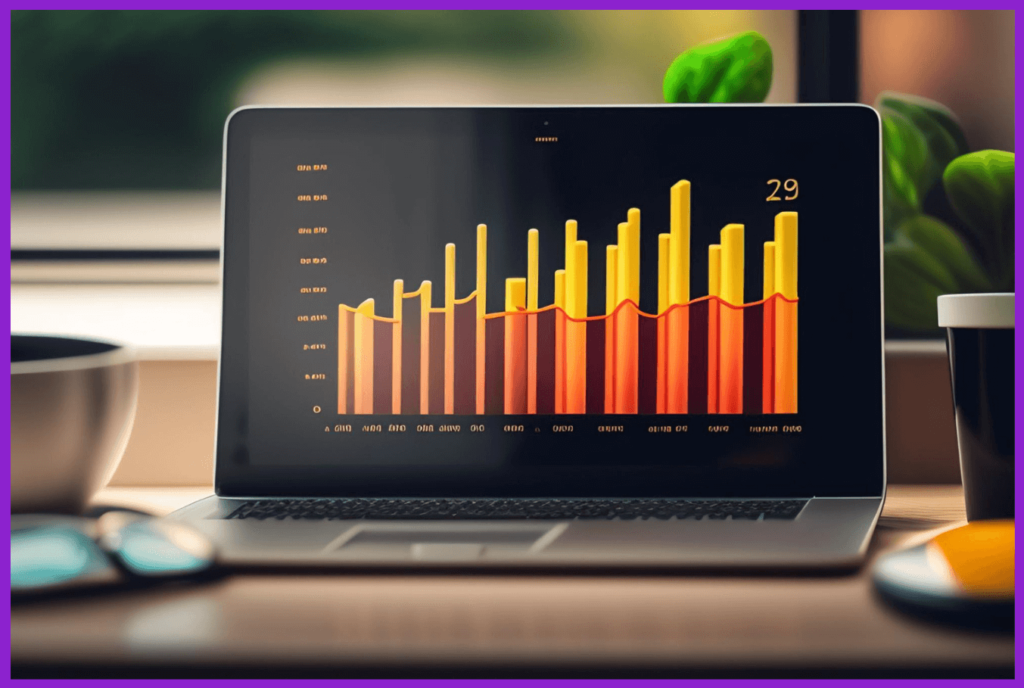
When it comes to demand generation, you are reaching out to an audience who do not know your product/service that can solve their pain points.
Sometimes your target audience might not be aware that they have a problem yet.
This adds the challenge of making them aware of their problem, positioning your product/service, and persuading them to choose your business over competition.
For example, to create demand for your product/service, you may have to push out blogs, case studies, whitepapers, run social media ads, or host webinars.
Then to capture the information of those prospects who are interested in your product or service, you can use lead generation tactics such as capturing leads through gated content, chatbots, product demos, or offering a free trial.
Why Demand Generation is the Best Marketing Approach for B2B?
Here are five critical reasons why demand generation is the best marketing approach for businesses in the B2B sector.
- Targeted Approach
Demand generation allows for highly targeted approach.
You can attract the right B2B businesses and decision-makers by understanding and addressing the specific needs and pain points of your target audience.
- Long Sales Cycles
B2B sales often involve long sales cycles.
Demand generation strategies such as content marketing and lead nurturing keep potential B2B customers engaged through this process.
This helps to build trust and establish your company as a thought leader in your industry.
- High Customer Value
In B2B, individual sales often represent a significant amount of revenue due to the high value of the products or services.
Demand generation helps to attract high-quality leads that are more likely to convert into these valuable customers.
- Builds Brand Awareness
As mentioned before, demand generation helps in building brand awareness for your business and not just used for attracting potential customers.
This can be particularly valuable in the B2B sector where businesses may not be as familiar with your brand.
- Measurable Results
Demand generation strategies often rely on digital channels and therefore provide measurable results.
This allows you to track ROI and optimize your demand generation strategies based on what works best.
Different Stages in a B2B Demand Generation Funnel
There are 6 stages in a B2B demand generation funnel and each of these stages requires a different approach and strategy to effectively generate demand and move potential leads through the sales funnel.
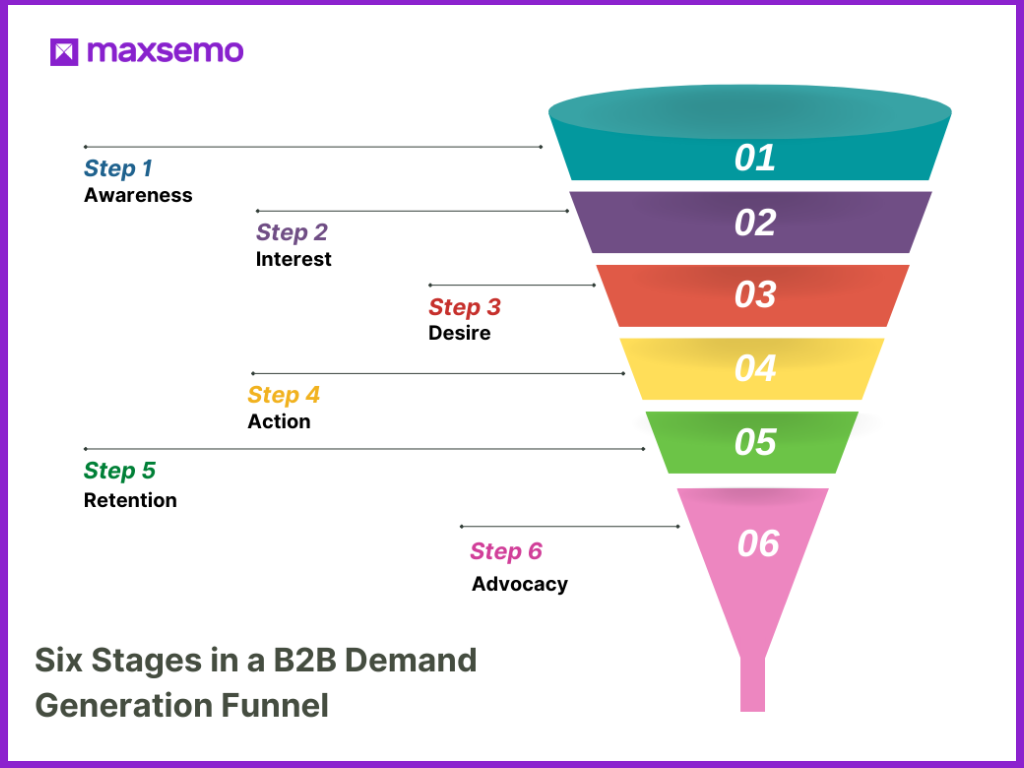
Awareness – This stage where you introduce your product or service. It’s about building brand awareness and making target audience notice your offerings.
Interest – This stage is about giving your customer prospects more information on what your product/service does and generating interest. It’s about turning your B2B prospects into marketing qualified leads.
Desire – This stage builds desire for your product/service and shows what it will do for the customer.
Action – This stage calls the customer to buy your product or service.
Retention – This stage focuses on keeping the customer engages with your brand after the purchase.
Advocacy – This is the final stage where satisfied customers become advocates of your brand.
11 Demand Generation Best Practices for Your B2B Company
Here are 11 demand generation best practices that you can consider for your B2B company, irrespective of the niche you are in.
1. Develop a Strong Content Strategy
You need to develop a strong content strategy with the aim of addressing the interests and needs of your target audience.
Through your website, you can push out content in the form of blogs, case studies, survey reports, and ebooks.
Your blogs can be about how your product/service can solve customers’ problems, challenges faced by customers in solving their respective problems, trends and developments happening in your industry/domain.
You can check out this article to know more about B2B blogging.
You can use tools like Google Trends, Exploding Topics, Answer The Public, and Buzzsumo to find the right B2B topics in your niche.
Create case studies on how your product/service helped your B2B customer in solving their problem. You can also include customer testimonials in those respective case studies as well.
Industry survey reports and ebooks are another two forms of content that can bring more targeted attention and recognition as an industry thought leader.
Whether it be blogs, case studies, or ebooks, make sure you update from time to time because your audience always look out for fresh content.
2. Leverage SEO to Boost Your Search Presence
Even though you’ve created great content that talks about thought leadership and addressing your prospects’ needs and pain points, your content need to show up prominently on search engine results.
Only through increased search presence, your prospects find your business (website) that have the solutions to their problem.

In order to achieve that, you have optimize your website with proper keyword research, on-page optimization, responsive web design, link building, and of course strong content strategy (as we talked before).
Instead of focusing solely on generating traffic to your website, focus your SEO efforts on building brand awareness as it will gives you an edge over competition in the long run.
When your target audience starts to be aware of your business then it leads to generating branded search traffic for your website.
Also, when people start talking about (or mention) your business in the online platforms you can track those ‘brand mentions’ and use it to amplify your SEO efforts.
3. Enhance Your Email Marketing Efforts
You can build a big email list by collecting emails from contact forms placed in your blogs, case studies, ebooks, and other pages in your website.
After filtering and segmenting that list, you can push out emails that are highly personalized and in a simplified format.
Make sure you test various deployment times to find the timings when the open rate is high and evaluate your sending frequency to avoid spam complaints.
You need to evaluate and audit the performance of your email marketing campaign based on click rates, email open rates, unsubscribe rates, spam complaints, and more.
Improve your email marketing efforts by analysing the data derived from the performance of your previous campaigns.
4. Add Social Media Channels to the Mix
When it comes to developing a demand generation campaign for your B2B business, social media channels play a critical role.
Adding social media channels into your campaign can help in amplify your brand message and at the same time interact with your potential customers.

For example, Linkedin has now become a key social media channel for B2B businesses (like SaaS, IT services, logistics, consulting, etc) as they can connect with entrepreneurs, professionals, and company executives who are more active on that platform.
Leverage those social media platforms where your B2B prospects are much more active and are interested in engaging with content related to your niche.
It can be Linkedin, Twitter, Facebook, Instagram, or even WhatsApp.
Don’t forget to include video in your social media strategy as it has the highest engagement rate compared to other content formats.
Leverage short and long-form videos using platforms like TikTok, YouTube, and Instagram Reels.
For creating videos, you can use tools like Animoto, Renderforest, InVideo, Canva, Synthesia, etc.
5. Invest in Account-based Marketing
Account-based marketing works when you have identified a small group of prospects or individual accounts.
As you picked these accounts because of their high-value, you need to customize your marketing efforts that address the pain points of each these accounts.
The goal here is to achieve higher revenue in a shorter time frame.
To build personalize marketing and sales tactics, you need to align your marketing and sales teams and their efforts.
Both teams will be in charge of targeting these accounts with personalized content and tailored messages.
You can use email, direct messaging, in-person events, webinars, etc to push out personalized content and messages to target accounts.
6. Nurturing High-Quality Leads
For the uninitiated, lead nurturing is the process of building relationships with leads (generated from your online channels) who have expressed interest in your product/service offerings but not ready to make a purchase.
By delivering personalized content, addressing the concerns raised by your prospects, and providing ongoing value, your marketing team can nurture leads and convert them into sales-qualified leads.
Lead nurturing is often done through email marketing.
Through email, you can continually drip content so that your prospects remember your company over competition.
7. Paid Ads to Aim Specific Segments of Your Target Audience
Paid advertising is a great way to focus on specific segments of your (larger) target audience.
For example, assume that you are a SaaS company that provides a platform for manufacturing businesses to digitalize their supply chain operations.
Instead of targeting broadly (i.e., manufacturing), you can use paid ads (say Google Search ads or Linkedin ads) to target one or more specific segments (say food processing companies, medical device manufacturers, or battery manufacturers).
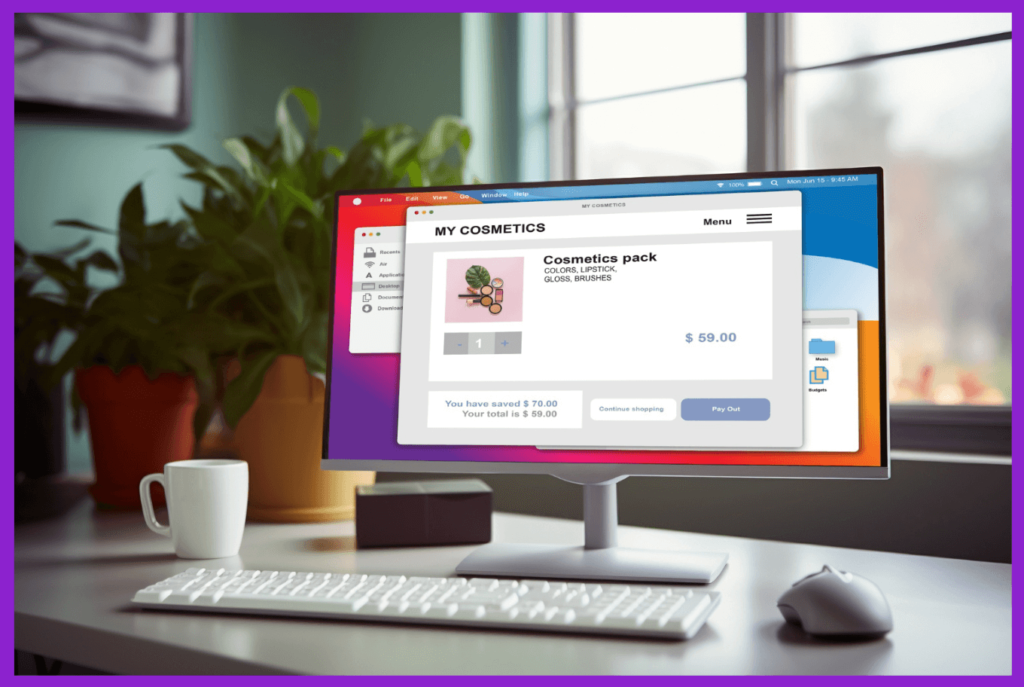
This way you can optimize your ad budget, increase the chances of getting leads, and reduce unwanted ad clicks.
You can refine your ad campaigns based on specific locations, demographics, interests or behaviours, thereby you can increase relevance, engagement, and generate demand for your product or service.
Retargeting is another ad strategy and in that you can build retargeting lists from website visits or prospects/businesses you’ve already engaged.
8. Leverage Offline and Online Events to Build Authority
Offline and online events can help in networking and building relationships with your target audience.
Hosting or participating in industry events, conferences, webinars, workshops, or trade shows can help you showcase your expertise and provide valuable insights.
This in turn helps establishing your brand as an authority and industry thought leader while also building trust and generating demand among the event attendees.
When it comes to hosting an offline/online event, you can invite your prospects or decision-makers from your target accounts to participate in your event so that you can lead them to a long-term partnership with your business.
9. Make Use of Marketing Automation Tools
Even if you start running your demand generation campaign, you may be facing challenges in managing it on your own.
There are mundane, repetitive tasks that takes up your time which include tracking your leads, lead nurturing, email drips, social media posts scheduling, tracking website traffic, email analytics, and social media performance, creating customized reports, etc.
All of these issues can be fixed through the use of automation tools such as HubSpot, Zoho Marketing Automation, Marketo Engage, Oracle Eloqua, and Salesforce Marketing Automation.
By integrating a marketing automation tool in your B2B demand generation campaign, you can capture and nurture leads, identify which leads are more engaged, accurately pinpoint the source where the leads generated, and what content lead to those conversions.
10. Customer-Intent Data Can Help You a Lot
By analyzing customer-intent data such as search queries, website traffic and interactions, and social media engagement, your marketing and sales teams can gain insights into the interests and needs of your target audience.
You can get this data from Google Analytics, Google Search Console and/or from the analytics provided by third-party marketing tools you currently use.
This data can enable your marketing campaigns to include more relevant and targeted messages that resonate with potential B2B customers, thereby increasing demand for your product/service offerings.
11. Consult with an Expert if You are Starting from Scratch
If you are new to demand generation landscape or you have no marketing resources to implement your demand gen campaigns then digital marketing consulting can help you.

A digital marketing consultant can advice you on building an in-house marketing team or hiring a marketing agency who has considerable experience in running demand gen campaigns.
The consultant can help you in creating a demand generation campaign that is tailored to your business growth and budget requirements.
They can also help in tracking the progress of the campaign when it is implemented by your inhouse marketing team or an outside agency.
How to Measure the Performance of Demand Generation Campaigns
How do you know whether your demand generation campaign is successful or not?
Whether it achieved your expected ROI? How to measure the effectiveness of the campaign?
Here are 8 metrics you can use to measure the performance of demand generation campaign for your B2B business.
- Marketing Qualified Leads (MQLs) – A marketing qualified lead is a lead whom your marketing team believes is likely to become a customer. When a MQL is identified, it is transferred to the sales team for further processing.
- Sales Qualified Leads (SQLs) – A sales qualified lead is a lead that your sales team believes is ready to make a purchase. You can track the percentage of MQLs turned into SQLs and how many SQLs got converted into paying customers.
- Cost Per Lead (CPL) – CPL tells you how much it costs your company to acquire one (high-quality) lead. To calculate CPL, divide the amount you spent on marketing by the numbers of quality leads generated.
- Cost Per Acquisition (CPA) – CPA tells you how much it costs your company to acquire one new customer. Here you divide the marketing spend by the number of new customers acquired.
- Return on Investment (ROI) – Here ROI is the percentage of how cost-effective is your demand generation efforts have been. There is no exact formula for ROI since it varies based on your goals and marketing investments.
- Customer Lifetime Value (CLV) – CLV tells how much amount you can expect a customer spend on your product/service during their lifetime. In order for your marketing investment to be worthwhile, your CLV must be higher than your CPA.
Customer Lifetime Value = Average Customer Value x Average Customer Lifespan
- Average Deal Size – It is the average amount your customers spend per transaction. To calculate average deal size, divide your total revenue over a certain period of time by the number of deals, or transactions completed during that period.
- Marketing Cycle Length – Marketing cycle length tells you how long it takes to get a new customer. You can calculate by determining the average amount of time between your first contact with a potential customer and their first purchase.
4 B2B Demand Generation Case Studies You Need to Know
Here are 4 B2B demand generation case studies you can consider as reference when you are building your own campaigns.
RocheMartin
RocheMartin is most trusted names in the professional training and coaching space and the company has built a suite of emotional intelligence solutions that were used by the likes of Google, Easyjet, and Oracle.
However, the majority of the company’s growth had been achieved through offline means, and they weren’t taking advantage of digital channels to acquire and retain customers.
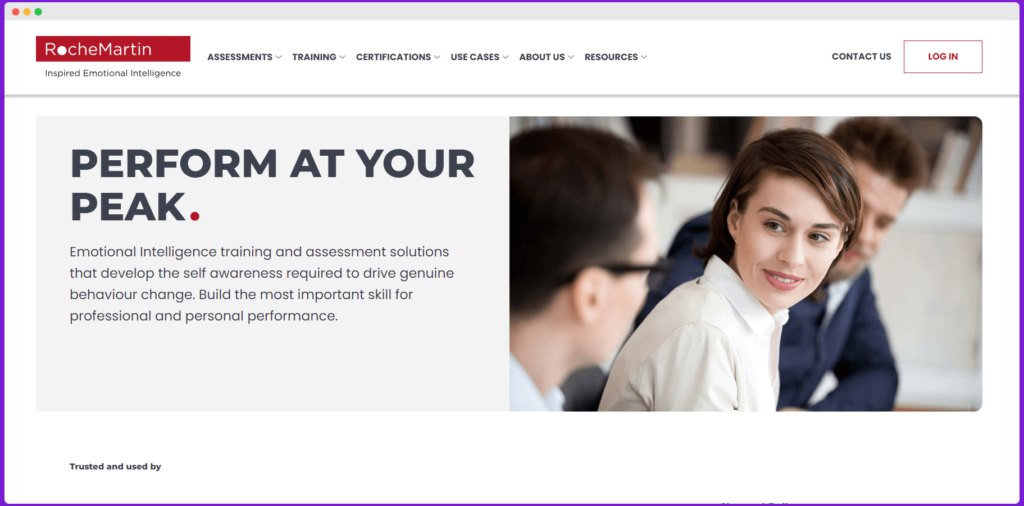
The company decided to build its digital capabilities from the ground up.
For that, they devised a demand generation strategy that can accelerate their growth across sales, marketing, and customer success, then deliver a growth programme that accelerated revenue.
After running the campaign, the company witnessed 133% increase in sales qualified opportunities, 602% pipeline increase in first six months, and 157% organic traffic growth for their company website.
Zipit Wireless
Zipit is an Internet-of-Things (IoT) solutions provider and they were confronted with a pivotal challenge.
To drive their growth, they need to enhance the quantity and quality of leads.
Generating qualified B2B opportunities was essential to meet their business goals, but it required a more effective and focused strategy.

Their demand generation strategy included precise audience segmentation to channel marketing efforts towards highly qualified prospects.
They created relevant and engaging content to nurture leads and heighten their interest in the services offered by the company.
They also focused on implementing paid media campaigns across key channels to boost online reach and traffic.
The company saw an 8X increase in qualified leads from paid and own digital media.
They also achieved 150% increase in the generation of new B2B sales opportunities and successfully achieved 1.4K visits per month for their website.
Abintus Consulting
Abintus is a media audit and media transformation agency that provide services like media auditing consultancy, media performance tracking, and media pitch management to companies in the consumer brands space.
The company encountered a series of challenges with their website, including poor performance, low search engine visibility, and a lack of qualified B2B leads.
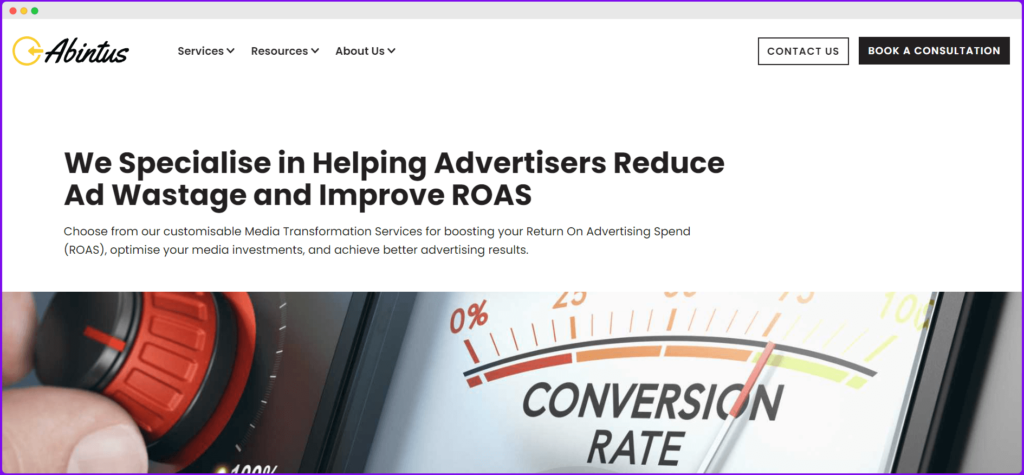
Their main objective is to enhance their online presence and effectively generating quality leads.
The company recognized the need to refresh their existing brand design and modernize it to better align with their service offerings, and to convey the associated benefits.
They also sought to showcase their renowned collaborations with well-known companies more prominently.
The company adopted demand generation approach and that yielded them great outcomes and measurable results.
That include increased website traffic, improved brand perception, Google SERP rankings for their target keywords, and improved lead generation efforts.
Digipart
Digipart is a B2B ecommerce company that offers custom machine parts across the United States.
The company wanted to harvest the current demand for custom machine parts across their target region using Google Ads.
They have tried different approaches to bring qualified traffic and generate B2B leads for almost six months.
With the help of an agency, Digipart decided to adopt demand generation strategy in order to improve their conversion rates and bring more targeted traffic.
They adopted this strategy to achieve their multiple goals and they include generating qualified traffic, qualified leads, improve conversion rates, reduce cost per lead, and translate their investment into additional revenue.
Conclusion
Keep in mind that demand generation is a strategic, long-term process that not only aims to create awareness and interest in your product or service, but also builds meaningful relationships with your potential customers.
By leveraging a mix of marketing strategies and tactics, your B2B business can effectively nurture leads, drive customer engagement, and ultimately increase sales.
As the business landscape continues to evolve, so too should your approach to demand generation, always staying ahead of the curve to meet your target audience’s needs.
